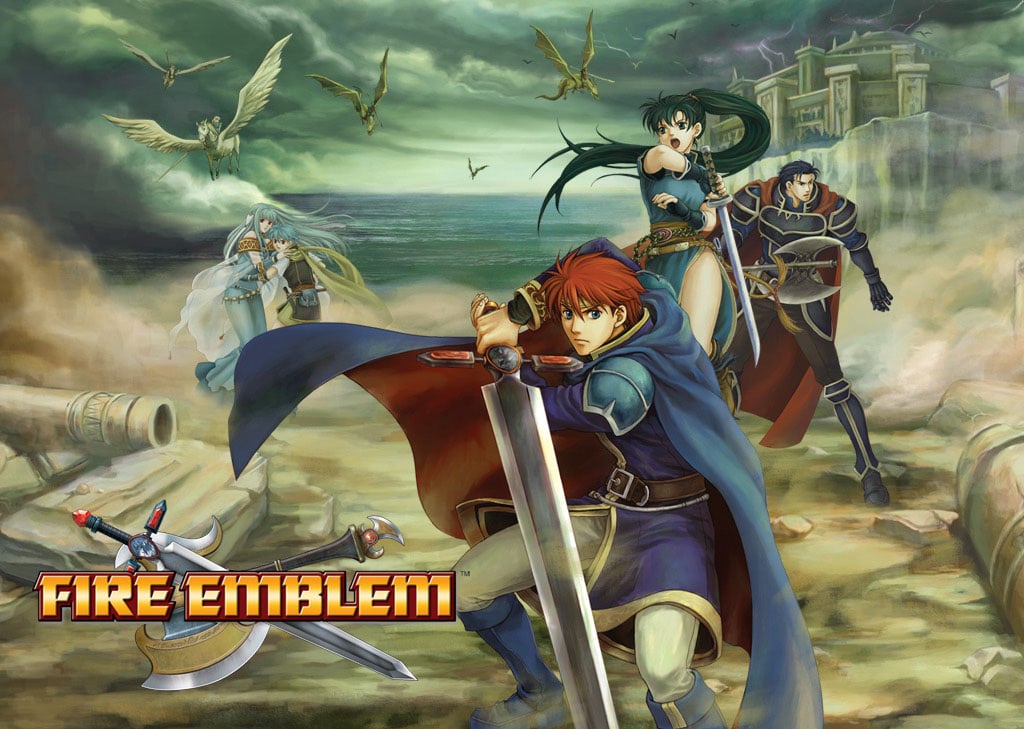
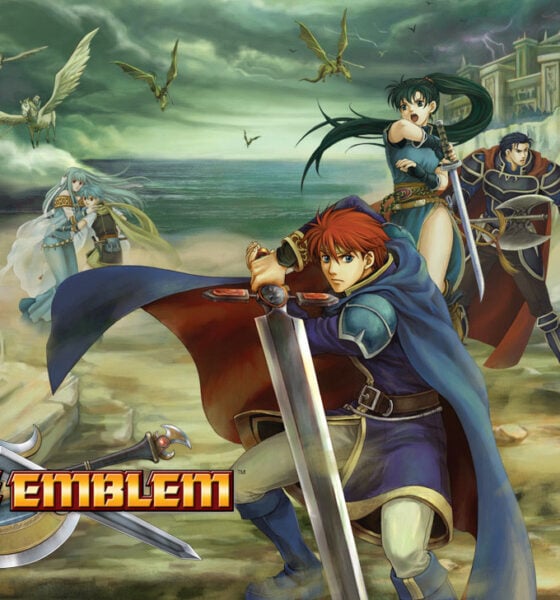
Features
Fire Emblem: The Blazing Blade is a GBA Epic in 32-Bit
Between hours of replay value, excellent presentation, and downright addictive gameplay, Fire Emblem: The Blazing Blade is the GBA at its best.
Revisiting Fire Emblem: The Blazing Blade
The Game Boy Advance’s library is nothing to scoff at. The 32-bit handheld was home to ports of both NES & SNES classics, plenty of innovative titles, and more than enough sequels to keep most of Nintendo’s premiere franchises in the spotlight. In many respects, the GBA refined 2D gaming even further — naturally building from where the Super Nintendo left off. Mega Man Zero would not have been possible without the SNES’ Mega Man X trilogy. The Minish Cap has all the flare of a 3D Zelda in two dimensions. The Binding Blade trims the fat its series put on during the Super Famicom era while serving as a fresh start for Fire Emblem. The Game Boy Advance is proof that handheld games can have as much depth as their console counterparts, and few titles exemplify that notion better than Fire Emblem: The Blazing Blade.
A prequel to The Binding Blade, The Blazing Blade was notably the first Fire Emblem game to release internationally. Prior attempts at bringing FE overseas were thwarted by lengthy scripts and complex mechanics. Nintendo Power even included a four page feature in issue 87 detailing Genealogy of the Holy War, to be localized as The Descent of Jihad before its quiet cancellation. It wasn’t until the burst in interest generated by Marth and Roy’s inclusion in Super Smash Bros. Melee that Intelligent Systems finally committed themselves to a proper localization.
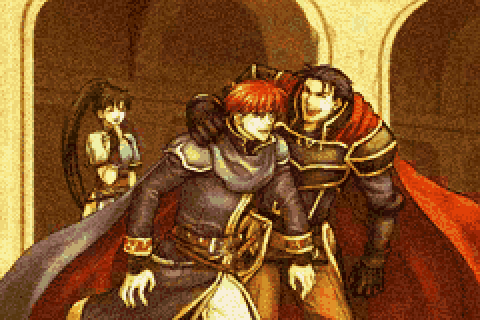
In many respects, The Blazing Blade feels like a game Intelligent Systems knew the world would have its eyes on. Overall, the difficulty has been scaled back relative to previous games, making FE7 very accessible for newcomers. The first 11 chapters serve as a dedicated tutorial that methodically teaches players how to contend with Fire Emblem’s many nuances. Replay value is beyond what is already expected of the franchise thanks to a detailed ranking system, the support library, multiple difficulty modes, and three campaigns to play through. The Blazing Blade is designed to leave a strong first impression and turn curious audiences into lifelong fans.
It certainly helps that FE7 has some of the best presentation on the Game Boy Advance. The Binding Blade already looked great, but The Blazing Blade has an extra layer of polish that makes everything look all the more refined. Portraits now utilize multiple expressions, with the main Lords having at least three distinct emotes each. Clothing is far more detailed and ornate, expressing character traits through accessories. Color composition is still fantastical, but no longer as garish or aggressively bright. CG artwork is displayed during pivotal story moments to lend gravity to what’s happening. Time of day is actually reflected in gameplay and cutscenes, from golden hour to the dead of night, while rain and snow effects toss weather into the mix. In-battle animations are even more stylish. Every detail makes it easier to sink into the experience.

Setting an important precedent that’s since become a franchise mainstay, The Blazing Blade introduces a (slightly) customizable avatar to stand in for the player. Faceless, silent, and non-playable, the avatar is a vessel for characters to acknowledge you without breaking the fourth wall. Your avatar is the game’s canonical tactician. You are actually ordering units around on the battlefield. If a unit walks six spaces, it’s because the tactician told them to move that far. If a unit engages in combat, it’s because the tactician ordered them to fight that enemy. Besides filling in your birthday, gender, and name at the start of each playthrough, the tactician has no concrete background. The most that can be inferred from the script is that you’re a drifter exploring the continent who probably isn’t from Bern.
The avatar’s inclusion is more charming than anything. The story goes out of its way to address you, but never to the point of distraction. The actual narrative stays fixed on the main cast and their struggles where it belongs. Brief asides to the avatar are mainly there for flavor and to help immerse yourself in FE7’s world. They’re also relatively well paced in the sense that characters don’t go out of the way to include the avatar in conversations where they don’t belong. While the main Lords do confide in you, you are a tactician and treated as such. The most attention the avatar gets is in The Blazing Blade’s tutorial: Lyn Mode.
The Noblewoman of Sacae
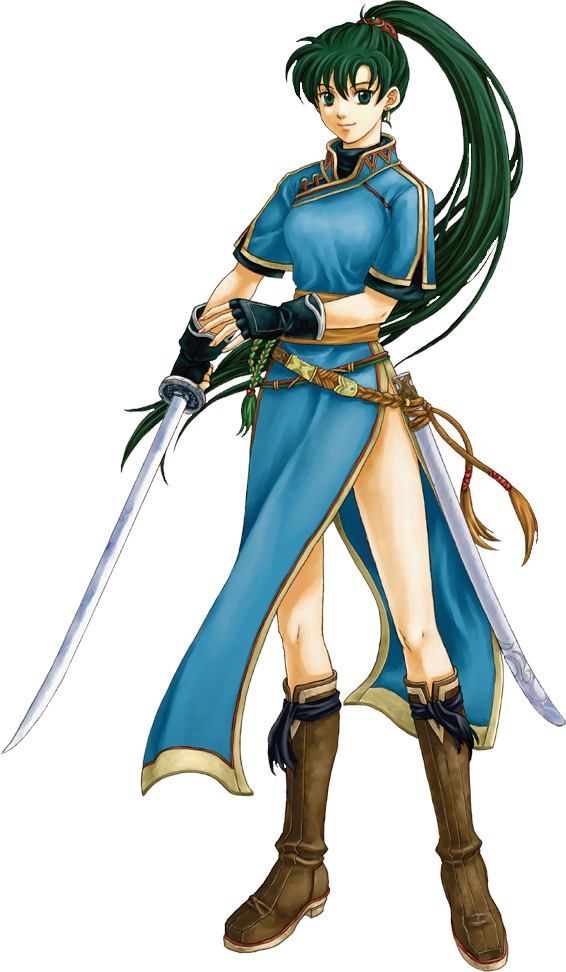
Encompassing the first eleven chapters (including the Prologue), Lyn’s campaign serves as a tutorial to just about everything Fire Emblem. The weapon triangle, magic triangle, terrain, moving, attacking, seizing, using items, visiting houses, talking to NPCs and recruiting enemies — virtually everything except the rescue mechanic and Supports is covered in painstaking detail. Lyn Mode is a fantastically thorough tutorial for anyone new to the franchise, but it can be a bit much for veterans. FE7 all but assumes this is the first strategy RPG you’ve ever played and wants you to walk away with a clear understanding of the mechanics at play.
While Lyn’s tutorial is actually optional in the Japanese release (so long as you own a copy of FE6 and a link cable), the localization makes her campaign a mandatory part of the experience. For someone already familiar with the series, sitting through tutorial after tutorial can feel like a chore. That said, the tutorial only needs to be played until you’ve beaten the game once. All subsequent playthroughs allow you to skip Lyn Mode altogether, jumping right into the bulk of the experience. For what it’s worth, Lyn’s campaign is fun in its own right and even has a nice flow after deactivating tutorials in Hard Mode. The whole endeavor lasts no longer than three hours and manages to tell a refreshingly low stakes story that still feels appropriately Fire Emblem.
Lyn is not The Blazing Blade’s actual protagonist, but only one of three leads. While ultimately the least important of the main trio, she is an endearing character whose smaller scope arc helps ease players into FE7’s setting. Where The Binding Blade was a grand-scale war styled after Marth’s own games, The Blazing Blade presents itself as a character-driven drama that happens to take place in a fantasy world. Politics are still in play, but not to the consequential degree they usually are for the series. Lyn herself is caught in an inheritance dispute that really only affects one region. She has no political aspirations either, her main goal being to reunite with her long-lost grandfather and find her place in the world.

Gameplay-wise, Lyn Mode feels like a condensed version of a full Fire Emblem campaign. There’s even a “where are they now?” epilogue for Lyndis’ Legion despite there being more than twenty chapters left until the actual staff roll. The only thing missing is a castle map. Pacing has an almost addicting quality that lasts long after the tutorial is over. It’s very easy to fall into a rhythm of playing “just one more chapter.” Lyn’s mode specifically benefits from how each map builds upon the last, introducing new concepts that get further fleshed out past Chapter 10.
The Prologue is a simple seize map with barely any terrain. You control one unit against two enemies on a small map with the weapon triangle in your favor. Chapter 1 pits three units against five enemies on a wider map littered with trees. All the enemies are axe wielders, but you only have two swords available. You need to play around the fact that one of your new Cavaliers will be at a disadvantage and utilize terrain bonuses. The map ends once all enemies have been routed. Chapter 4 is a survival map where you need to keep an NPC alive for seven turns. You can either literally hold down the fort and create choke points, or engage enemies head-on with your strongest units.
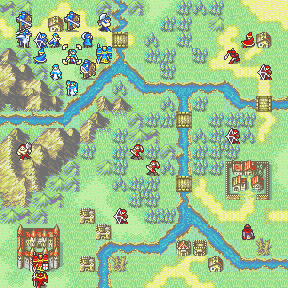
By Chapter 9, you’re playing a large fog of war map where early reinforcements force you to proceed with caution. The fact you can only see so far in advance means you need to be ready to improvise. A mountain ridge creates a forked path, prompting you to split up your army into two squads. A forest of trees dead-center on the map slows down your units and keeps them locked in battle turn after turn. Chapter 10 goes all out by letting you deploy everyone in Lyn’s army for her final map. Rain every few turns locks you into a loop where you need to wait out the weather, ideally using the movement penalty to avoid conflict while closing in on enemies. Cavalier reinforcements show up from turns 5 to 10 — around the same time, you’d be nearing the castle — supporting an already sturdy boss.
The level design does a great job at teaching you the importance of strategy even without tutorial prompts. Lyn Mode is preparation for the main game, but it also stands as its own side story. Not a full game’s worth of content, but a comprehensive enough taste of Fire Emblem for when you want to kill an afternoon. Impressive character writing keeps even the longest cutscenes engaging. Everyone has a distinct personality and a clear voice. No two characters are alike in tone or mannerisms, each unit uniquely themselves.

Fire Emblem is at its best when captivating characters can speak with one another. Shadow Dragon’s story is compelling in spite of its simplicity largely due to Marth and Nyna’s fantastic repertoire. On the flip side, The Binding Blade’s plot’s weight is occasionally undercut by having Roy mainly talk with the relatively dry Merlinus. The Blazing Blade uses a rotating supporting cast to give multiple characters a chance in the spotlight. Lyn alone has Kent, Sain, Florina, Wil, and Matthew all chiming in on a regular basis, with the rest of her army still getting more lines than the average Fire Emblem unit.
Lyn’s status as a relative outsider to Elibian culture allows for smoother exposition. She informs the avatar and her comrades on what she knows having grown up in Sacae, while the rest of the cast fill her in on Elibe’s political situation. Lyn undergoes racism as a Sacae tribeswoman, actively scorned for being a “prideful savage.” Marquess Araphen outright refuses to help Lyn because he deems her inability to tearfully beg for help barbaric. The most political support Lyn can garner is a vow of neutrality arranged by Eliwood, Marquess Pherae’s son and FE7’s actual main character. Eliwood stands out as one of the few Elibian nobles respectful of Sacaen culture, going out of his way to help Lyn because he deems it right.

Despite lower narrative stakes, there is real weight to Lyn’s arc. Her story is one about identifying and finding your place in the place. Her family was slaughtered, yet she fights to not only connect with the grandfather she never knew but build a found family of her own. Lyn meeting her grandfather is a surprisingly heartfelt moment considering how much she worked to reach this point. Her pleas for him to live on so they can spend some time together hits hard and is rooted in what drives Lyn as a character. Likewise, it’s genuinely bittersweet when Lyn and the avatar part ways — her reaction underscoring just how much she’s grown alongside you.
While self-contained, Lyn’s story does a good job of setting up important threads for the actual narrative. Eliwood is introduced in a heroically appropriate fashion, the antagonistic Black Fang is hinted at from a distance, and an alarming amount of supporting characters are more important than they let on. Her mode also sets up themes of family and personal independence that go on to play a large role in the narrative proper. Lyn’s campaign is hardly the best gameplay Fire Emblem has to offer, but it’s fun for what it is and ultimately makes The Blazing Blade a better experience.
The Knight of Lycia

Chapter 11 is where the real adventure begins and controls swaps over to Eliwood, Roy’s father from The Binding Blade. Eliwood’s arc is the heart of FE7’s story, and is far more emotionally charged than Lyn’s. His journey heavily focuses on confronting loss and how the death of a loved one can invoke change. Eliwood’s initial motivation is simply finding his missing father Elbert. His biggest concerns are whether or not his dad is part of a conspiracy to destabilize Elibe. Reuniting with his father only for Elbert to die in his arms serves as a newfound call to action. Eliwood commits himself to finish his father’s fight, working to save Elibe at all costs.
Eliwood’s relationship with Ninian adds another layer of tragedy to his arc. A half-dragon/half-human on the run from the Black Fang, Ninian and Eliwood find themselves in a star-crossed romance. The two grow fond of one another and you can explore their relationship further in their Support, with Eliwood outright saying that he loves Ninian in the A-Rank event. Their deep bond combats the idea that man and dragon cannot co-exist — which retroactively makes The Binding Blade’s themes richer — while their separation in the last act thrusts Eliwood into a depression. The pain Eliwood suffers makes his strength in the face of it all the more inspiring. He spends the last stretch of the story noticeably depressed, but he never loses his spirit or will to fight.

It helps that Eliwood has a strong supporting cast to give him a shoulder to lean on during heavier moments. The Blazing Blade’s three Lords have amazing chemistry with one another. In-talking between the trio helps get information out in an organic way while fostering natural development. Lyn and Eliwood share a bond from her campaign one year prior, while Hector is the closest thing Eliwood has to a best friend. By Chapter 15, you’ll have three Lords to manage. Stat and growth distribution means each Lord also fulfills a different gameplay role.
Lyn is good at landing critical hits and avoiding damage, but cannot afford to get hit herself. Hector is a tank who can dish out as much as (if not more than) he can take but lacks the speed he needs to double until later. Eliwood is designed as a jack-of-all-trades whose “balanced” growths mean he’ll end up one of your strongest or weakest units depending on nothing but sheer luck. To be fair, luck is part of the fun when it comes to Fire Emblem and Lords can make up for bad level-ups by promoting. Promotion is still accomplished through class-specific crests once a unit has reached level 10, but new Heaven Seals let Lyn and Hector promote relatively early. Since Eliwood doesn’t promote until Chapter 27, Heaven Seals offer flexibility when it comes to the other Lords.
Lyn becomes a Blade Lord who can use Bows, Hector becomes a Great Lord who can use Swords, and Eliwood becomes a Knight Lord who can use Lances. Of the three promotions, Eliwood’s is easily the best as it also nets him a horse to expand his movement. Although the Lords benefit heavily from promoting, promotion bonuses on a whole have been lowered from FE6. Most units are fine promoting well before Level 20, but it can be wise to hold off until 15 – 18 range — especially if a unit has decent growth rates. Experience isn’t exactly scarce either, so waiting can be strategically sound. The biggest benefit to promoting right away is gaining access to S Levels. Weapon Levels cap at A for unpromoted units, and they can only have one A-Rank before promotion. Promoted units have no limits on A Ranks and can level one weapon type to S, giving them a notable edge in combat.
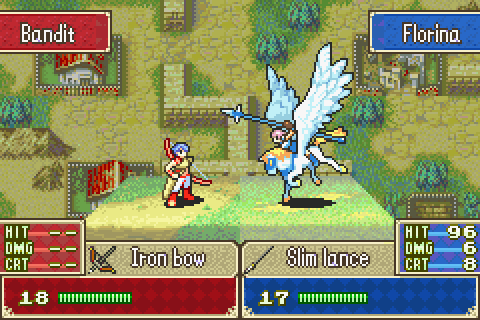
While Eliwood must be deployed in every chapter, maps are fairly lax on Hector and Lyn. They share forced deployment in a few narratively relevant chapters but are otherwise optional. FE7 is generous enough with deploy slots where they might never even need to be benched. That said, a solid cast of well-defined characters with plenty of class variety to go around encourages you to play around with Lordless teams. Pre-promoted units are powerful, incentivizing you to shake up your team whenever a new one joins. Units like Florina, Sain, and Kent have the potential to turn into beasts if you properly trained them in Lyn Mode. New recruits join at a steady pace, ready to replace the dead or offer your team a new edge.
Support conversations make a comeback from FE6, albeit greatly retooled to mitigate the mechanic’s tedium. There is no longer a cap on support points that units can gain in a single map, allowing you to comfortably grind ranks. Of course, supports still encourage turn grinding, but FE7’s lengthy campaign means you can naturally A-Rank several couples without hampering your pace. All three Lords are fleshed out characters in their own right and their supports give them even more depth. Side characters like Raven, Priscilla, and Lucius have detailed backstories you can only learn through support conversations. The support triangle between Wil, Rebecca, and Dart is a full-blown sub-plot hiding in plain sight. It’s downright impressive just how sophisticated The Blazing Blade’s supports are compared to its predecessor.

A support library in the Extras and Prep menu actually outlines who can support who, eliminating The Binding Blade’s need for guesswork. The prep menu, in general, has been overhauled with welcome quality of life improvements. Pressing start now triggers the next battle automatically. Units can use stat boosters and promotion seals from the menu. Viewing the map not only lets you reposition units but check what shops are selling by clicking on them. The only convenience FE7 loses from FE6 is the prep shop. You can still sell items from the inventory, but no more buying low-tier weapons whenever you want. This naturally makes resource management more important. You need to stay on top of visiting armories or else you’ll run into a weapon shortage.
Besides checking support compatibility, the Fortune option allows you to reference your current Rank in the five scored categories (Tactics, Survival, Funds, Exp, Combat) and visit the Augury for battle predictions. While not always accurate due to localization changes the script did not account for, the Augury tends to offer sound advice that helps you get a leg up on the next map. This can be beneficial since Eliwood’s campaign is naturally mode complex than Lyn’s when it comes to map design. The Blazing Blade skews much easier than The Binding Blade, but FE7’s maps are just as creative.
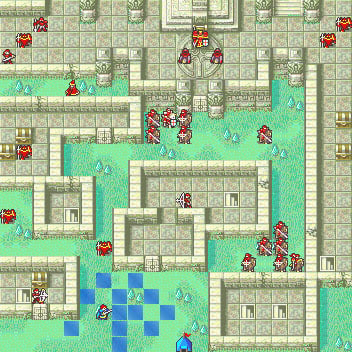
Chapter 19 is a seize map with three paths to the boss room. You can either unlock the front door with a key or Thief, break in through a side room to tear down the northern wall or sneak in through a breakable wall in the east. A second boss with his own squad stationed halfway through the map means you need to frontline your strongest units in a vanguard. There are four doors and five chests to unlock, encouraging you to split your army up into small squads. Between all that, you need to account for stealing the VIP Card off a reinforcement Thief, finding both Secret Shops, and recruiting Legault. You need to think several turns in advance to plunder the map successfully.
Enemies are not as dangerous as they were in FE6 — in large part due to a more forgiving hit rate all around — but that doesn’t mean FE7’s enemy design is easy. Enemies will prey on weaker units and go in for the kill if underestimated. They’ll flee to heal and make smart use of terrain if they can. Enemies are well placed more often than not. Advancing too far without consideration can put your army in a tight spot. There’s always variety in squads. It’s not unusual for archers and mages to be surrounded by stronger units. Promoted enemies are often guarded by their prior classes. The closer you get to the throne, the harder enemies generally get. Later chapters go all out when it comes to enemy density, ready to flood promoted units at you in waves.
While it only makes sense that Eliwood’s campaign goes out of its way to flesh out concepts introduced in Lyn Mode, some ideas are pushed too far. Weather is a neat mechanic in theory, but frustrating in large doses. Chapter 25B is a rout chapter where it snows every few turns until the blizzard stops at chapter 30. Gameplay is set on a large map with six buildings to unlock, five of which are hiding more enemies. You need to split up your army efficiently and make each turn count to beat the snowfall. On top of that, one of two recruitable enemies arrives with reinforcements on turn 10. Who you get depends on how many doors you unlocked, yet another factor to strategize around with impeded mobility. The way weather shakes up progression is strategically interesting, but its benefits are more aesthetic than mechanical. 25B would still be an engaging chapter without snow.

Despite there being no route split like in The Binding Blade, alternate chapters can be triggered depending on your actions. There are two versions of Chapter 23 with different bosses determined by whether or not Eliwood, Hector, and Lyn’s combined level is over 50. Whoever you did not fight goes on to be Chapter 27’s boss later. Likewise, there are two variations of Chapter 25. You fight Kenneth if your spellcasters (Erk, Serra, Priscilla, & Lucius) are higher levels than your infantry (Guy, Dorcas, Barte, & Raven), and Jerme if not. Considering how much ground FE7 covers between Lyn Mode, Eliwood Mode, and a post-game mode, the lack of a route split makes sense.
Along with their requirements being much laxer, Gaiden chapters are now framed like actual side quests instead of narratively sensitive chapters relevant to getting the true ending. You’re even given the option to turn them down if you are so inclined, with no penalty other than not playing that specific chapter. Like FE6, Gaiden chapters prioritizes unique gimmicks, at times offering a fresh change of pace from the typical gameplay loop. Chapter 16x is framed like a mini-game where you need to talk to the boss rather than beat them. Taking the upper path means avoiding combat altogether while marching head-on aggros the whole map and spawns reinforcements if you want extra experience. Chapter 29x has no enemies whatsoever outside the arena. The map is merely an opportunity to breathe, rack up some extra levels, and restock before the finale.

In a way, chapter gimmicks feel like The Blazing Blade’s means of making up for being easier than its predecessors. The difficulty curve is still perfectly respectable, but gameplay prioritizes keeping newcomers comfortable over stimulating veterans. This isn’t to say that FE7 is unstimulating or does not offer a challenge — simply that it does so on a more forgiving level than the first six installments. Eliwood’s first few chapters are nice and easy, but almost spill together on account of the low difficulty curve. Mid-game maps like 19 raise the difficulty curve considerably and start demanding actual strategy. With the exception of a few breather maps for pacing purposes, the homestretch is full of FE7’s hardest chapters. Long, complex maps end the game on a high note by testing the fruits of your labor.
Chapter 26 is a fog of war map set in a pitch-black castle. You need to protect a meek prince for fifteen turns, but not before fighting your way through hosts of enemies. While you can simply protect Zephiel, the map encourages you to beat Thieves to Chests and go out of your way to recruit Nino & Jaffar. Doing so puts you in range of Ursula, who can easily kill injured units with her Bolting magic. Chapter 27 is a downright endurance match with over forty enemies including reinforcements. Chokepoints will be used against you if you aren’t careful. Ballistae rain arrows as units get closer to the boss. Vaida and her army of Wyvern Knights will kill anyone you were foolish enough to leave by the starting position before hunting down the rest of your army.
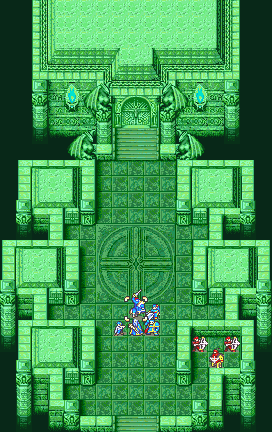
The Final Chapter is one of the best endgame maps to come out of the series. Most Fire Emblem games lower the difficulty curve for the last chapter, often serving up a final boss that can be easily beaten with a certain strategy. The Binding Blade is hard, but Roy will effortlessly kill Idunn so long as he uses the game’s eponymous weapon. The Blazing Blade goes all out for the final challenge, offering up a legitimate test of how well you’ve managed your resources and trained up your army. Even then, you need to stay on top of your tactics to properly handle everything the endgame throws at Eliwood’s army.
The first half of the chapter is a straight-up boss rush against extremely well-equipped enemies who come in mobs. Every turn unlocks a new door where bosses are hidden behind. Once free, they relentlessly chase down anyone in their path. Proper positioning and anticipating (or even baiting) how enemies will behave on their turn is key to keeping everyone alive. After killing all the bosses on the map, the path to Nergal opens. Nergal himself is guarded by two casters, one with a Fortify ready to heal and the other using Berserk to turn your units against each other. Failing to have someone in place to kill the Druid immediately can be damning.
Nergal’s high stats all around make him a genuine challenge to kill. Failing to properly level your party correctly can make the penultimate battle near impossible without Athos — a powerful Archsage who joins in the final chapter specifically to counteract this fail state. Beating Nergal triggers a new map with the actual final boss and several long-range enemy spellcasters conveniently out of reach. The Fire Dragon demands the use of your strongest units with their strongest weapons, leaving little room for error. Everything about the map makes FE7’s Final Chapter deeply satisfying to beat.

The Blazing Blade’s story has just as many high points as the gameplay, heavily leaning into emotional character drama. Matthew finding Leila’s corpse and mourning her if he survived up to the Dread Isle adds a tragic layer to his character. Eliwood clutching his father’s dead body while begging him to open his eyes puts into perspective just how young he is. The strong use of dramatic irony keeps the plot compelling on reflection. Elbert sacrifices his life to save Ninian and Nils only so Eliwood can bring them both back mere moments later. Eliwood strikes down a dragon without thinking just to realize he’s killed the woman he loves. Nergal functionally wins. Eliwood saves Zephiel’s life only for the Prince of Bern to wage war on the entire continent decades later, painting Elibe in bloodshed.
Between craven curs and blackhearted friends, medieval cursing lends dialogue some extra flavor. Even in spite of localization issues, FE7’s dialogue is beaming with personality. Certain chapters feature hidden asides to the tactician if you bring specific units. Unique conversations before boss fights are now also more common, fleshing out your army where appropriate. Legault can speak with several members of the Black Fang as a former member himself. Uhai recognizes that Guy is from Sacae and challenges him to a duel. The fact Eliwood, Hector, and Lyn all share dialogue with multiple bosses also means you’re bound to trigger a few naturally.

The Epilogue provides detailed character endings for everyone this time around, not just the units who fought in the last chapter. The story taking place twenty years prior to the events of The Binding Blade necessitates a certain level of tragedy to explain why specific characters are absent. No matter what, Canas always dies leaving his son behind and Legault wanders the land trying to overcome his own grief. Paired endings now extend to the supporting cast, but even couples aren’t spared from heartbreak. Priscilla is left by two of her three suitors; Jaffar and Nino are tragically separated from their children, effectively orphaning them; Renault abandons Isadora without so much as a word, leaving her to spend the rest of her life looking for answers. Consequences follow FE7’s cast for the rest of their lives.
Even your avatar’s ending can be potentially depressing. Play poorly enough and the tactician’s blurb will explicitly call your strategies “incomprehensible” — as if you only beat the game through dumb luck. Complete a near-flawless campaign and FE6’s war is retconned into being fought over you. No matter the ending, a high score is saved for each campaign under Battle History in the Extras menu. Every difficulty has its own page as well, pushing for repeat playthroughs and a “perfect run.” Ranking the player is a decent incentive to encourage replay value as is, but The Blazing Blade goes one step further with a post-game mode starring Hector.
The General of Ostia
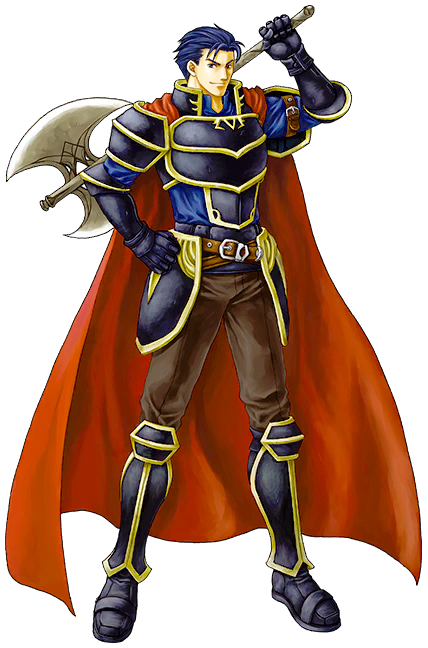
As the name might suggest, Hector Mode is a version of Eliwood’s campaign told from Hector’s perspective. Eliwood is still the main character, but his arc (particularly his relationship with Ninan) is downplayed in favor of better developing his right-hand man. Where Lyn is an outsider and Eliwood is traditionally heroic, Hector is refreshingly brash. He’s as hot-blooded as he is endearingly reckless. He helps Eliwood search for his father despite it being a politically poor move for Ostia and putting a dangerous target on his back. Oswin advises them to leave after their battle with Eric in Laus, but Hector doubles down. His loyalty to those he cares about is more important than any threats to his life or Ostian politics.
Beyond swapping the main Lord, Hector Mode also comes with new chapters that help expand the story — filling in a few narrative gaps Eliwood’s campaign skips over. Hector’s Chapter 11 (Another Journey) is a small route map that details how he left Ostia to go help Eliwood. Chapter 15 (Talons Alight) is a short and sweet defense map that shows how Eliwood & Hector held Castle Laus after capturing it. Chapter 19xx is a Gaiden map within a Gaiden map that unlocks secret dialogue on top of an already expanded script. Chapter 25 (Crazed Beast) is a triple seize map that lets you tackle all three outposts in any order. Chapter 30 (The Berserker) is Hector’s trial to wield a sacred weapon that dooms him to die in battle, foreshadowing his death in FE6. Lastly, Chapter 32x is a cramped map trapped in a magic seal that highlights Nergal’s backstory before the finale.
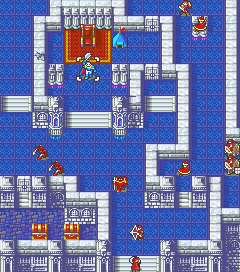
Besides the new maps, most pre-existing chapters rearrange enemies or add in new obstacles to keep gameplay fresh. New enemy placement fundamentally changes how you approach maps by offering a steeper challenge altogether. Hector’s version of Noblewoman of Sacae features two ballistae where Eliwood’s had none. Whereabouts Unknown replaces the archers guarding the castle with swordsmen to combat Hector’s axe proficiency. Unfulfilled Heart expands Vaida’s squad and places even more Wyvern Knights by the Lords’ starting position. Victory of Death has considerably more promoted enemies and they’ve been rearranged to sit closer to terrain. Living Legend goes so far as to change your starting position and move Pent closer to Jasmine and Paul, making it even harder to get the 700 EXP needed to unlock 23x.
Unlike Eliwood Mode, Hector Mode embraces The Binding Blade’s love of obscure secrets (for better or worse). There are two Hector exclusive units with noticeably inconvenient recruitment requirements compared to the rest of the cast. Farina is the third sister in FE7’s Pegasus trio and shows up exclusively in Chapter 25. Recruiting her costs a whopping 20,000 gold, with no room to bargain. Farina isn’t too bad of a surprise so long as you have enough money, but Karla is another matter entirely. Karla’s recruitment is outright convoluted. She only appears in 32x if Barte is at least a Level 5 Warrior and joins after he survives one round of combat with her in the arena. Recruiting her doesn’t even feel worth it since Karla is one of the weakest units on the roster.
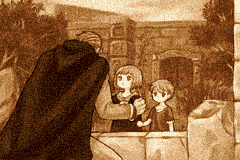
19xx is the only Gaiden chapter with an unlock criteria that is easy to miss. The map is locked behind getting Nils to level 7 in Lyn Mode and then defeating Kishuna in 19x before they retreat. For reference, Nils joins at Level 1 in Chapter 7 — that’s five chapters of grinding including 7x. This also makes 19xx and its associated dialogue in the Final Chapter impossible to see if you dare skip Lyn’s campaign. Part of the appeal of Hector’s campaign is getting to see the full picture as if it were FE7’s “director’s cut.” There’s nothing wrong with secrecy in games, but Hector Mode takes its best-kept secrets to a level that would make FE6 blush.
For what it’s worth, obscure secrets do pair well with Hector Mode’s focus on difficulty. Little changes add up to make the experience much harder. Hector is Lord locked as late as Chapter 29, depriving you of an amazing promoted unit until the home stretch. The only real saving grace is that Eliwood becomes a considerably better unit when he can be promoted early. Hector Hard Mode comes with a slew of changes that force you to approach each situation with an intelligent strategy. Enemies have higher stats (including recruitable foes, making some units better in turn). Money is tight, turning careful resource management into a conscious part of any playthrough. Availability has been lowered across the board, demanding that you overcome already challenging maps with a smaller army. Hector Mode — Hard or otherwise — is the perfect remedy for series veterans left wanting after a standard playthrough.
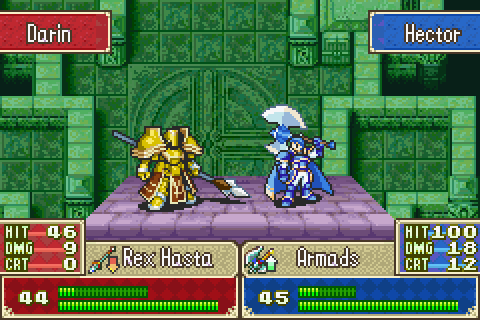
Interestingly, the story can also be changed to remove the avatar altogether if you happen to be that much of a Fire Emblem purist. Skipping Lyn Mode prompts you to create a new tactician, which can actually be turned down. Should you refuse, the main story will play out with absolutely no references to you. Certain scenes are naturally changed to accommodate your absence and Eliwood & Hector now speak to one another in their respective Epilogues instead of the tactician. The only penalty to doing a tacticianless playthrough is that Athos never gives you Afa’s Drops, an item that increases a unit’s growth rate by 5% for each stat.
There are some minor story differences in Hector Mode even if you do create a tactician, albeit nothing significant. Hector comes up with the idea of raising money for Fargus at the arena instead of Eliwood. Hector has to earn Armads himself instead of Athos finding it for him. Uther is treated like a proper character whose death isn’t brushed aside in a throwaway line, but actually goes on to greatly influence Hector’s arc. Eliwood has a secret conversation in Hector’s last map that basically sums up one of the story’s main themes:
“When Lord Uther was in trouble, you weren’t at his side. You’re angry with yourself. It’s true, isn’t it? I was the same way. I couldn’t save my father… I couldn’t save Ninian… Over and over, I blamed myself… But, you know, that’s just a way of running from the sadness of loss. I think you’ve realized that already . . . You must see that, but if you continue to pretend you do not, you will lose sight of something terribly valuable.”
Confronting loss is a key part of being human. Hector is an emotionally stunted man who cannot so much as muster tears for his family despite his family, but Eliwood is there to guide him through the pain he feels. There to offer solidarity. Hector is a flawed character, but that just makes him the most compelling Lord of the lot. His point of view adds a layer of nuance to the story that isn’t present from Eliwood’s point of view. Hector’s struggle to grieve also makes him a better foil for Nergal than Eliwood in terms of characterization.

Nergal’s search for power warps his mind until he loses sight of his initial goals. What began as a journey to reunite with his wife turns into a never-ending pursuit of Quintessence. Nergal is completely disconnected from humanity, so much so that he cannot remember his loved ones until his dying moments. He runs away from the sadness of loss, failing to confront what he lost and forgetting forevermore. Nergal turns away Athos, the one person trying to help him, and turns a friend into an enemy for life. Hector may be cold, but he genuinely does care. He takes what Eliwood says to heart. Hector doesn’t need to cry to prove he loved his family. He upholds his brother’s ideals in death. He does not lose sight of the people who loved him. Nergal isn’t a particularly impressive antagonist, but Hector draws interesting parallels that make his presence interesting on reflection.
It’s almost staggering just how much new content Hector Mode has. Even reused chapters tend to have some new edge to keep them dynamic. Extra story beats, a fuller campaign, and a difficulty curve that plays up strategy over RPG elements serve up an amazing victory lap. The Blazing Blade manages to offer a compelling enough experience as is between Lyn and Eliwood’s campaigns, but the concept and execution of Hector Mode elevate a great game into an amazing one.
A GBA Epic in 32-Bit
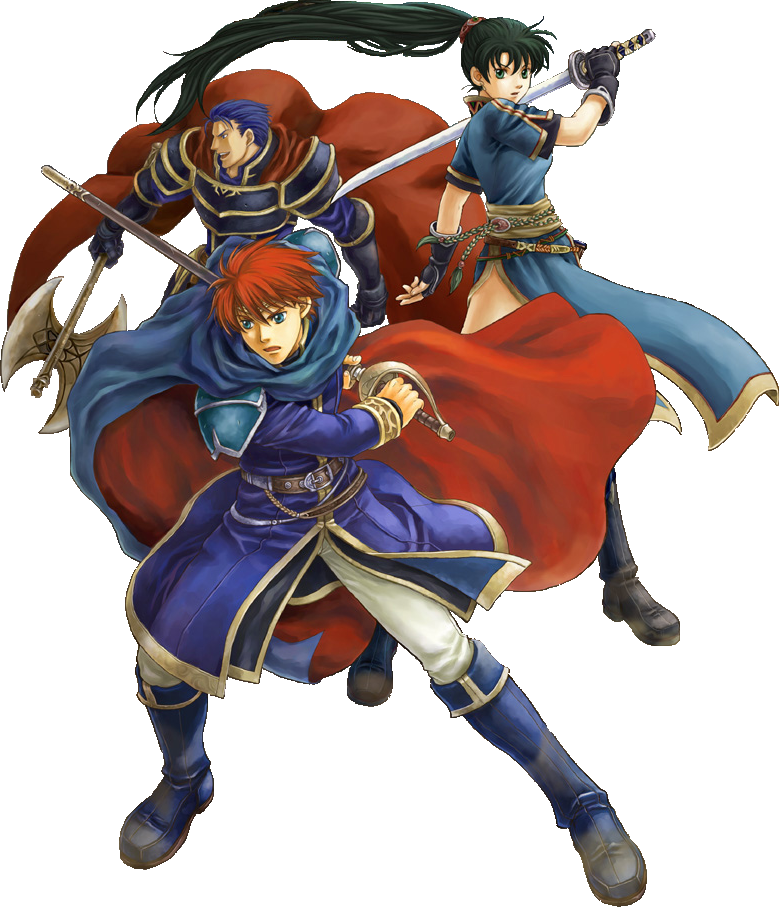
Not all Lords are created equal, but The Blazing Blade thrives off its three campaign structure. Lyn Mode is Fire Emblem broken down to its bare essentials — a taste of what to expect from the series and the best introduction anyone could ask for. Eliwood Mode is classic Fire Emblem through and through, a young hero’s journey of growth framed around saving the land they love. Hector Mode is an excellent post-game that fills in narrative gaps with extra content in a campaign already packed with secrets.
FE7 builds on The Binding Blade‘s foundation while setting important precedents that would go on to reshape the franchise down the line. The avatar is a gimmick at the end of the day, but one that feels like a sincere attempt to immerse the audience into the experience. Accessibility and quality of life features iron out the gameplay loop’s edges without compromising the series’ identity. The story’s stakes are low on a political scale, but high when it comes to gripping character drama. Between hours of replay value, excellent presentation, and downright addictive gameplay, Fire Emblem: The Blazing Blade is the GBA at its best.

-

 Features3 weeks ago
Features3 weeks agoDon’t Watch These 5 Fantasy Anime… Unless You Want to Be Obsessed
-

 Features3 weeks ago
Features3 weeks ago“Even if it’s used a little, it’s fine”: Demon Slayer Star Shrugs Off AI Threat
-

 Culture3 weeks ago
Culture3 weeks agoMultiplayer Online Gaming Communities Connect Players Across International Borders
-

 Features1 week ago
Features1 week agoBest Cross-Platform Games for PC, PS5, Xbox, and Switch
-

 Game Reviews3 weeks ago
Game Reviews3 weeks agoHow Overcooked! 2 Made Ruining Friendships Fun
-

 Guides4 weeks ago
Guides4 weeks agoMaking Gold in WoW: Smart, Steady, and Enjoyable
-

 Game Reviews3 weeks ago
Game Reviews3 weeks agoHow Persona 5 Royal Critiques the Cult of Success
-

 Features2 weeks ago
Features2 weeks ago8 Video Games That Gradually Get Harder
-
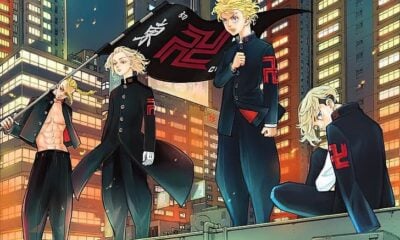
 Features2 weeks ago
Features2 weeks agoDon’t Miss This: Tokyo Revengers’ ‘Three Titans’ Arc Is What Fans Have Waited For!
-
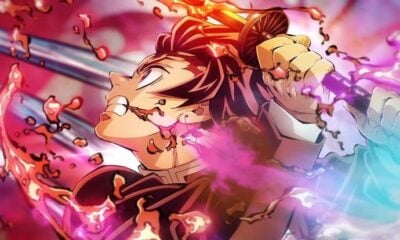
 Features1 week ago
Features1 week agoThe End Is Near! Demon Slayer’s Final Arc Trailer Hints at a Battle of Legends
-

 Guides2 weeks ago
Guides2 weeks agoHow to buy games on Steam without a credit card
-
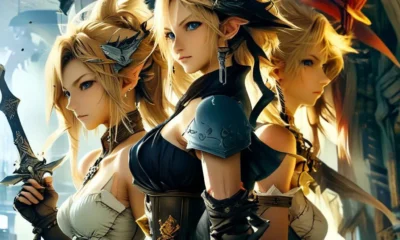
 Game Reviews1 week ago
Game Reviews1 week agoFinal Fantasy VII Rebirth Review: A Worthy Successor?



















